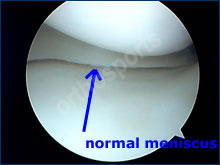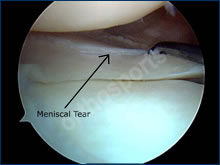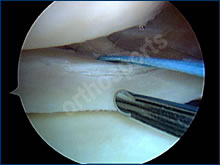Inside This section
Meniscal Repair
Function
The meniscus is a soft rubbery structure between the femur and tibia. There is one on both sides of the knee a medial and lateral. Meniscal tears are very common. The meniscus is often incorrectly referred to as cartilage in the community. Cartilage is the smooth lining of the joint at the ends of the bone..

Normal Meniscus

Meniscal Tear
The meniscus acts as a…
- shock absorber to take some of the force within the knee
- stabiliser of the knee
- assists with lubrication
Once a meniscus is torn, it no longer functions as it should and if symptomatic, is best partially removed. Because the meniscus has a very poor blood supply it is unlikely it will heal itself. Tears are described according to the type of tear as simple or complex. Without the meniscus, there is an increased risk of osteoarthritis in the long term. The severity and timing of arthritis depends on numerous factors such as your age, activity levels, weight and degree of meniscal damage. This is usually a very slow process.
Meniscus Repair (Arthroscopic Technique)
History Of Injury
There does not need to be a specific injury. Athletes usually but not always tear their meniscus with a specific injury usually a twisting force but in older people it can result from minimal or no trauma. Some people will feel a pop or something go in the knee. The pain is not usually severe and most people can continue with sports or at least can walk around without too much pain.
Symptoms And Signs
- swelling usually begins the next day and is usually not severe
- pain is usually localised to the side of the knee where the tear is
- locking of the knee is when the knee gets stuck so you can’t move it, usually it can’t be straightened. This is because a fragment of the meniscus gets stuck between the bones.
- giving way usually caused by pain
- clicking
Diagnosis
This can usually be made on the history and examination. An MRI test may be ordered to confirm the diagnosis and to exclude other pathology but this is not always necessary and may delay treatment.
Treatment
Initial treatment involves rest, ice, elevation and bandaging. There is no urgency to be seen by a surgeon unless you have a locked knee in which case you can damage the meniscus as it gets caught between the bones of the knee joint.
Most meniscal tears require an arthroscopy (see Arthroscopy ). The torn meniscus can be partially removed or repaired (see below).
Meniscal Repair
Because the meniscus has a poor blood supply it has a limited potential to heal. Only tears in the outer half of the meniscus have the potential to heal. The decision to attempt a repair is based on age, activity levels, occupation and sporting demands.
Most patients with a repairable meniscus are under 45 years of age and up to 80 percent of these are associated with a tear of the anterior cruciate ligament. An MRI scan helps determine the extent of the tear but the final decision to repair can not be made until the time of surgery as it depends on the size, site and the quality of the remaining meniscus. There is no point in repairing a meniscus which is unlikely to heal.

Suture placed in meniscal tissue

Suture holding meniscus in place
Repair can usually be performed arthroscopically without any separate incisions using special devices, but occasionally one or two other incisions in the skin may be required. There are advantages and disadvantages of meniscal suture.
Advantages
- Maintain protective role of meniscus
- Reduces the risk of arthritis
Disadvantages
- Longer rehabilitation period
- Longer restriction of work and sport activities
- Failure of the meniscus to heal (15-20%) due to its poor blood supply
- Slightly increased risk to neurovascular structures
- Damage to articular surface from some of the devices used
Overall, if a meniscus can be repaired (in the right patient with the right type of tear), it is best to do so as it protects the knee from premature arthritis.
Post-Op
The post-op instructions will vary from one knee to another depending on the extent of the repair and damage to other structures. Usually the surgery is done as a day only procedure. You may require crutches and a splint .Your weight bearing and bending may be restricted again depending on the extent of the repair. Time required off work varies from a few days to a few months depending on your occupation. Sporting activities can resume at 3-6 months.
If your meniscus does not heal, you may develop ongoing symptoms and require further arthroscopic surgery to remove the torn portion of the meniscus which has not healed.
Complications
Any surgical procedure has a risk of complications. These are rare with an arthroscopy, however they can occur. Every precaution is taken to minimise the risk. Complications can be related to the anaesthetic, general in nature it can happen with any surgery or be specific to knee arthroscopy.
Bleeding
Bleeding into the joint can occur as a result of the surgery. A small amount of bleeding is not uncommon, however if your knee becomes swollen and tight, you should rest, elevate and ice it. The knee may need to be drained in the rooms and occasionally a repeat arthroscopy is needed.
Oozing
Oozing from incisions can occur, and is usually not a problem. You can change the dressing yourself using antiseptic or have your local doctor do it if you are concerned.
Infection
Infection is rare. If you become unwell, or the knee becomes increasingly swollen or red, you should be assessed as soon as possible. It can cause damage to the surfaces of the joint and result in stiffness. Treatment involves antibiotics and often further surgery.
Damage to Vessels or Nerves
Damage to vessels or nerves can occur, particularly with meniscal suturing. This can result in numbness in the skin and weakness in the lower leg. Some numbness, tingling or irritation around the skin cuts can occur but significant damage to major structures is extremely rare.
Reflex Sympathetic Dystrophy
This is a condition resulting from overactivity of the nerves around the operative site. Its cause is not well understood by the medical profession and it is difficult to treat. Fortunately it is very rare after arthroscopy.
Deep Venous Thrombosis
DVT or blood clots in the leg can cause calf pain and swelling, which damage vessels or nerves. These are also rare after arthroscopy. If they do occur you may require blood thinning medication in the form of injections or tablets.
Failure to Relieve Pain
This is not common but unfortunately some operations may not be entirely successful in relieving pain. Some knees may require further investigation or even a repeat arthroscopy.
Allergic Reactions
Allergic reactions to medications or materials used in the operating room.
Joint Stiffness
Joint Stiffness can occur no matter what the procedure, this is minimised and treated with physiotherapy.
Pressure
Pressure on areas of the body in the operating theatre causing nerve damage.
Diathermy Burns
Diathermy burns from cautery device used in most open operations (very rare).
Limp
Limp can occur from muscle weakness.
Any medical complication you have heard about can occur, especially if you already have a pre-existing medical problem. Such complications include heart attack, stroke, kidney failure, pneumonia, bowel obstruction, bladder infection or obstruction etc. Serious medical problems can lead to ongoing health concerns, prolonged hospitalisation or rarely death.
